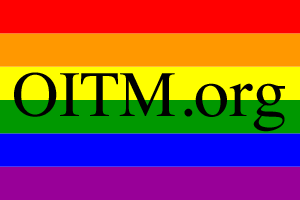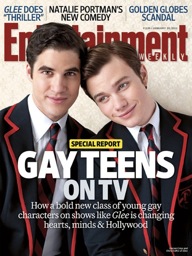Reprinted with permission
from the Rutland Herald / Barre-Montpelier Times Argus,
Feb. 6, 2011
The 17-year-old Vermont high school junior, hoping to put a face on the
state's population of gay, lesbian, bisexual and transgender youth, eagerly
agreed to this paper's request to publish his name, profile and photo on the
front page.
"It's a really awesome opportunity," he said.
So why am I masking him here as "Hart" (not his real name) and generalizing
the specifics of a coming-of-age story understood by an estimated 10 percent
of society?
Vermont has advanced as a leader in equality legislation throughout Hart's
life. The state adopted an anti-discrimination law just before his birth in
1993, then became the first to approve same-sex unions in 2000 before adding
full marriage rights in 2009.
But that doesn't mean everyone supports Hart and his peers. Read, listen or
log onto any national news outlet the past several months and you'd learn
about a rash of bullying, harassment and suicides involving teenagers facing
questions about their sexuality.
Vermont isn't immune to the problem. One-third of the state's gay and
lesbian students say they've been bullied, according to the most recent
Youth Risk Behavior Survey of nearly all eighth- through 12th-graders - more
than double the percentage reported by straight peers. Half of all gay and
lesbian students have found themselves in a physical fight and a quarter
threatened or injured with a weapon at school.
"It's all over the news," Hart says, "but I feel that not enough people care
about this issue, or if they do care, not enough people are doing anything
about it."
The student recalls seventh grade. For a majority of boys, middle school
brings the surprise that girls can morph into magnets. But for Hart,
opposites didn't attract.
"My first realization was when I was 12 - I knew that I was different."
Was it simply a phase? And, if not, what would people say?
"It's just not something that anyone in middle school really talks about or
knows how to talk about. And it was something I didn't want to admit to
myself."
That changed when Hart went to high school. In ninth grade, he met a
boyfriend who supported him when he told his parents. In 10th grade, Hart
joined his school's Gay-Straight Alliance, one of more than 30 such groups
in communities throughout the state.
"Freshman year I wasn't involved - mostly because I had the assumption that
if I joined, everyone would find out."
The feared paparazzi never popped up. Instead, Hart stepped forward himself.
During a nationwide "Ally Week" last fall, he asked classmates to sign a
pledge to "not use anti-lesbian, gay, bisexual, transgender language or
slurs" and "intervene, if I safely can, in situations where students are
being harassed."
Hart, who has faced verbal slurs but no physical threats, also is helped by
Outright Vermont. The statewide nonprofit advocacy organization began in
1989 after a national survey reported higher rates of depression and suicide
attempts among gay and lesbian youth that, in turn, can increase school
truancy and alcohol and drug use.
Two decades later, a new generation of problems is making news.
"It's devastating," Outright executive director Melissa Murray says of the
most recent headlines. "Youth are dying, but the recent media attention is
making people pay attention. We've been invited in to so many different
schools that never would have invited us before."
Last fall alone, Outright presented programs to 1,000 students, many in
conservative communities in the state's Northeast Kingdom. According to the
organization's most recent Safe Schools Report Card, nearly half of
Vermont's 61 public high schools now have gay-straight alliances and 57
percent offer a gender-neutral bathroom, with 11 "top ranked" boasting both
of those supports as well as specific anti-harassment programs.
(Log onto www.outrightvt.org for the full list.)
Life seems to be looking up for Hart and his Vermont peers. The man who
championed the state's new same-sex marriage law was just inaugurated as
governor, while Entertainment Weekly dedicated a recent cover to the media's
advancement of gay teens.
"How did gay teens go from marginalized outcasts and goofy sidekicks," the
magazine wrote, "to some of the highest profile - and most beloved -
characters?"
Then again, Hart knows real life doesn't always follow a script. After this
newspaper finished the teenager's profile (headlined "Student hopes to
silence hate by speaking out") but before it took his picture, his parents
expressed mixed feelings about publication.
His mother worried about Hart's security - would taking aim at harassment
instead attract it? - but ultimately decided he was old enough to make his
own decision.
His father voiced similar concerns: What would others think, and how would
they respond? But he spoke less about the possible reaction of his son's
classmates than of the potential static from his own co-workers and
neighbors.
The safest course, he believed, would be to stay silent. And so this paper,
lacking a photo and full family consent, chose not to run the profile.
Hart, bowing to the decision, stopped communicating on his social networking
sites for weeks. Recently, however, he has Twittered peers about a new
boyfriend, written Facebook condolences to the family of the latest
teen-suicide victim, and resumed his Human Rights Campaign e-mails to
politicians in support of marriage and military equity.
"It's definitely not what most teenagers do," he says of his advocacy, "but,
in my opinion, everyone should have equal rights. People make a lot of
assumptions about the LGBT community, when really we're just like everyone
else."
Hart still lacks parental permission to be named or photographed by this
paper. But that hasn't stopped the teenager from speaking out.
"Someone," he reasons, "has to be that person who stands up."
kevin.oconnor@rutlandherald.com
from the Rutland Herald / Barre-Montpelier Times Argus,
Feb. 6, 2011
The 17-year-old Vermont high school junior, hoping to put a face on the
state's population of gay, lesbian, bisexual and transgender youth, eagerly
agreed to this paper's request to publish his name, profile and photo on the
front page.
"It's a really awesome opportunity," he said.
So why am I masking him here as "Hart" (not his real name) and generalizing
the specifics of a coming-of-age story understood by an estimated 10 percent
of society?
Vermont has advanced as a leader in equality legislation throughout Hart's
life. The state adopted an anti-discrimination law just before his birth in
1993, then became the first to approve same-sex unions in 2000 before adding
full marriage rights in 2009.
But that doesn't mean everyone supports Hart and his peers. Read, listen or
log onto any national news outlet the past several months and you'd learn
about a rash of bullying, harassment and suicides involving teenagers facing
questions about their sexuality.
Vermont isn't immune to the problem. One-third of the state's gay and
lesbian students say they've been bullied, according to the most recent
Youth Risk Behavior Survey of nearly all eighth- through 12th-graders - more
than double the percentage reported by straight peers. Half of all gay and
lesbian students have found themselves in a physical fight and a quarter
threatened or injured with a weapon at school.
"It's all over the news," Hart says, "but I feel that not enough people care
about this issue, or if they do care, not enough people are doing anything
about it."
The student recalls seventh grade. For a majority of boys, middle school
brings the surprise that girls can morph into magnets. But for Hart,
opposites didn't attract.
"My first realization was when I was 12 - I knew that I was different."
Was it simply a phase? And, if not, what would people say?
"It's just not something that anyone in middle school really talks about or
knows how to talk about. And it was something I didn't want to admit to
myself."
That changed when Hart went to high school. In ninth grade, he met a
boyfriend who supported him when he told his parents. In 10th grade, Hart
joined his school's Gay-Straight Alliance, one of more than 30 such groups
in communities throughout the state.
"Freshman year I wasn't involved - mostly because I had the assumption that
if I joined, everyone would find out."
The feared paparazzi never popped up. Instead, Hart stepped forward himself.
During a nationwide "Ally Week" last fall, he asked classmates to sign a
pledge to "not use anti-lesbian, gay, bisexual, transgender language or
slurs" and "intervene, if I safely can, in situations where students are
being harassed."
Hart, who has faced verbal slurs but no physical threats, also is helped by
Outright Vermont. The statewide nonprofit advocacy organization began in
1989 after a national survey reported higher rates of depression and suicide
attempts among gay and lesbian youth that, in turn, can increase school
truancy and alcohol and drug use.
Two decades later, a new generation of problems is making news.
"It's devastating," Outright executive director Melissa Murray says of the
most recent headlines. "Youth are dying, but the recent media attention is
making people pay attention. We've been invited in to so many different
schools that never would have invited us before."
Last fall alone, Outright presented programs to 1,000 students, many in
conservative communities in the state's Northeast Kingdom. According to the
organization's most recent Safe Schools Report Card, nearly half of
Vermont's 61 public high schools now have gay-straight alliances and 57
percent offer a gender-neutral bathroom, with 11 "top ranked" boasting both
of those supports as well as specific anti-harassment programs.
(Log onto www.outrightvt.org for the full list.)
Life seems to be looking up for Hart and his Vermont peers. The man who
championed the state's new same-sex marriage law was just inaugurated as
governor, while Entertainment Weekly dedicated a recent cover to the media's
advancement of gay teens.
"How did gay teens go from marginalized outcasts and goofy sidekicks," the
magazine wrote, "to some of the highest profile - and most beloved -
characters?"
Then again, Hart knows real life doesn't always follow a script. After this
newspaper finished the teenager's profile (headlined "Student hopes to
silence hate by speaking out") but before it took his picture, his parents
expressed mixed feelings about publication.
His mother worried about Hart's security - would taking aim at harassment
instead attract it? - but ultimately decided he was old enough to make his
own decision.
His father voiced similar concerns: What would others think, and how would
they respond? But he spoke less about the possible reaction of his son's
classmates than of the potential static from his own co-workers and
neighbors.
The safest course, he believed, would be to stay silent. And so this paper,
lacking a photo and full family consent, chose not to run the profile.
Hart, bowing to the decision, stopped communicating on his social networking
sites for weeks. Recently, however, he has Twittered peers about a new
boyfriend, written Facebook condolences to the family of the latest
teen-suicide victim, and resumed his Human Rights Campaign e-mails to
politicians in support of marriage and military equity.
"It's definitely not what most teenagers do," he says of his advocacy, "but,
in my opinion, everyone should have equal rights. People make a lot of
assumptions about the LGBT community, when really we're just like everyone
else."
Hart still lacks parental permission to be named or photographed by this
paper. But that hasn't stopped the teenager from speaking out.
"Someone," he reasons, "has to be that person who stands up."
kevin.oconnor@rutlandherald.com

